-

The Simple Guide To Understanding Kitchen Sinks
 Share on Facebook
Share on Facebook
May 4, 2017
This post is designed to help you understand some of the different materials and styles utilized by kitchen sinks.
Builder Supply Outlet carries a ton of various types of sinks and brands including Bala and Elkay,
We’ll discuss both materials and styles so you completely understand your options.
MATERIALS
Don’t let the vast amount of sink materials make buying the right sink more difficult than it should be.
They’re all easy to understand when you break them down. Let’s get started…
STAINLESS STEEL

These are among the most popular sinks on the market. Some say 70% of all sinks are stainless steel.
Stainless steel is relatively inexpensive and comes in various installation types.
They’re classified in terms of gauge. The lower the gauge steel the heavier, while the higher gauge is lighter. Most sinks tend to fall between 15-24 gauge, while the majority of residential sinks are usually between 18-22 gauge. In terms of inches, this means the steel sheeting used to make the sinks has a thickness that ranges from .048″ to .030.″
The gauge has very little impact on the overall quality of the sink. At the same time, a heavier gauge sink can be slightly more resistant to denting and less noisy. Stainless steel tends to be a louder than other materials, although many sinks feature padding or spray coating to help reduce the noise.
Keep in mind that stainless steel kitchen sinks tend to scratch more easily than other sink materials. They also will show water spots more clearly, so they’re harder to keep clean than other sinks. On the positive side, stainless steel offers excellent resistance to heat and stains.
CAST IRON
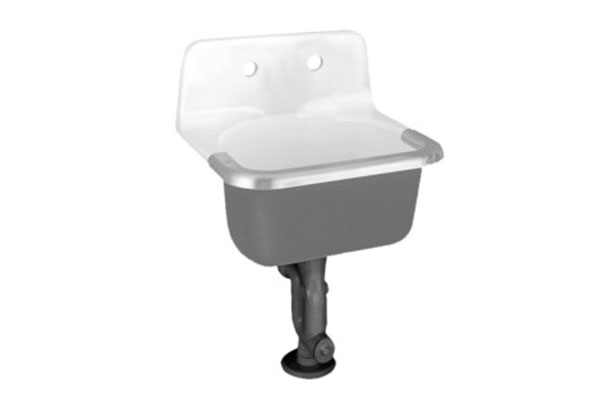
Cast iron is one of the oldest sink materials.
And it’s bright, glossy, enamel finish is extremely popular and lasts for decades.
Cast iron sinks are made by casting iron. Bare iron is prone to rusting, so cast iron sinks receive a heavy porcelain enamel finish. If you stripped the enamel off, the sink would would have the same texture as a cast iron skillet. The enamel is tough and resists stains and scratches. The enamel is actually melted glass that’s been fused to the bare iron.
Cast iron sinks are very easy to keep clean and they don’t tend to spot, while staying resistant to light and fading. They are very heavy, so installation is a little more involved, including the need for good support.
Cast iron is also fairly pricey compared to stainless steel.
One thing you need to understand is that the enamel on a cast iron sink can chip. If the bare iron base is exposed, it’ll start to rust.
COMPOSITE
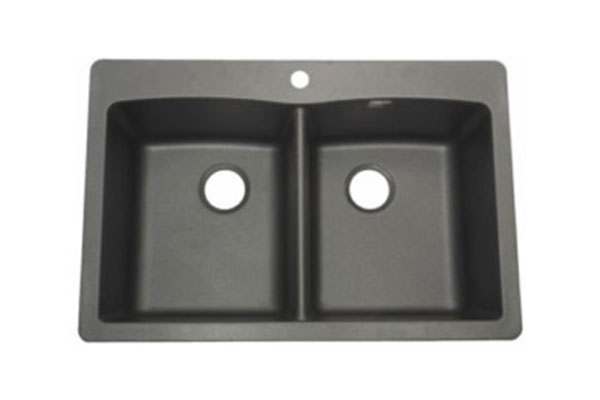
Composite kitchen sinks are comprised of a granite or quartz composite.
They’re made by combining crushed granite or quartz with a resin filler. The mixture is typically 70%-80% rock and 20%-30% resin. This produces a material that has many of the same aesthetic qualities of real granite or quartz without the maintenance and durability issues.
Each type of composite sink is tough and resistant to stains and scratches. Granite does tend to hold up better than quartz. In fact, some manufacturers claim that granite composite sinks are the most durable and long-lasting sinks available.
FIRECLAY
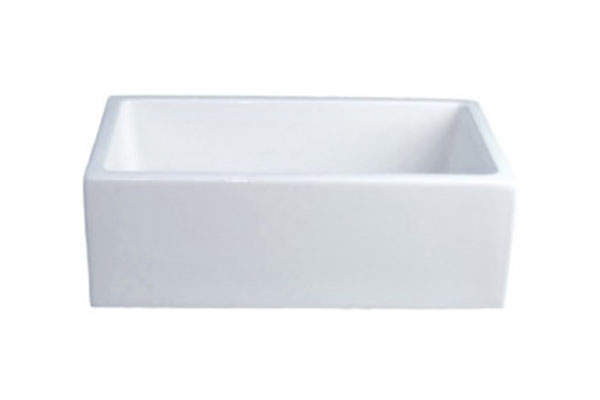
Fireclay sinks are made by molding a ceramic clay into the shape of the sink. Then it’s dried at a high temperature for nearly 40 hours. Once the clay is dry, porcelain enamel is applied and the sink is placed in a tunnel kiln at an extremely high temperature for around 20 hours.
This process fuses the enamel to the clay, while greatly increasing the strength of both. Fireclay sinks are generally even more durable than cast iron. However, fireclay isn’t indestructible. The enamel can chip from the impact of a dropped pot or glass.
Fireclay kitchen sinks can be pricey.
Although fireclay sinks come in a wide variety of styles and installations, the farmhouse style is the most popular.
OTHER
The materials we just discussed are the most common. You can also get sinks made from glass, granite, marble, copper, and other exotic materials. Just make sure to study them hard and learn about their durability and maintenance before you buy.
Now let’s discuss styles…
STYLES
Let’s begin our discussion.
SINGLE BOWL

A single bowl sink has one basin.
Single basin sinks are usually available in compact sizes. This makes them perfect for situations where space is limited. The basin of a single bowl sink is bigger than a double bowl sink designed to fit into the same space. A larger single basin can make cleaning large dishes such as pots, oven trays, and crock pots far easier.
Cleaning a single bowl kitchen sink is also going to be quicker due to reduced amount of corners and edges.
Single bowl sinks are also cheaper than their equivalent two or three bowl varieties.
DOUBLE BOWL
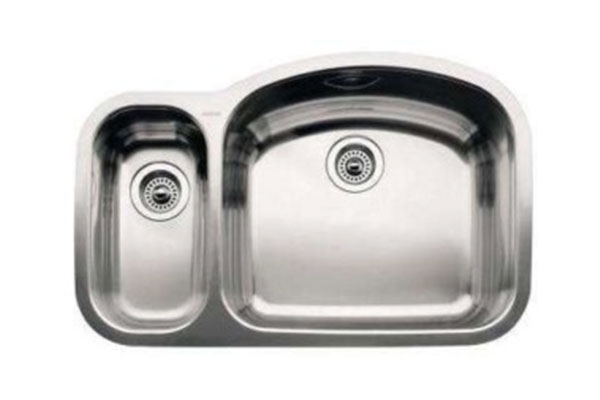
The majority of kitchen sinks are double bowl.
A double basin sink is ideal because of its flexibility. If you do a lot of cooking that involves larger dishes, you’ll need to make sure that the basins of your sink are big enough to comfortably wash them.
Double bowl sinks come in a wide array of configurations. You can get two equal-sized bowls of the same depth, two equal bowls of different depths, and unequal size bowls.
FARMHOUSE

Farmhouse sinks, also known as “Apron” sinks, feature a large forward-facing section that replaces a section of the counter.
They’re often the perfect choice for people looking for a traditional or country-style design.
Farmhouse sinks are available in single and double basin varieties, with single bowl sinks being the most common.
They tend to be pricey and require a very involved installation.
TOP MOUNT
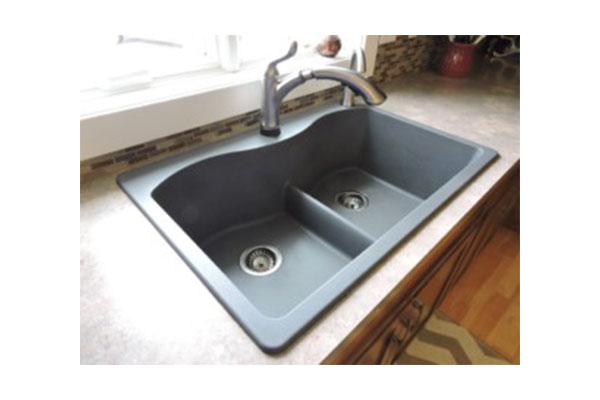
This style is designed to be dropped into a pre-drilled hole in your countertop.
Top mount kitchen sinks almost always have a rim or lip that hold the sink in place to create a finished look. They’re also known as “drop-in” sinks. Top mount sinks are relatively easy and inexpensive to install. The lip of the sink reduces the need for an internal support system under the countertop.
This style sink doesn’t have the sleek, modern appearance of undermount sinks and it’s easy for the area between the lip of the sink and the counter to accumulate scum and dirt.
UNDERMOUNT

An undermount sink is mounted underneath the countertop. There is no lip or rim, which means that the edge of countertop drops off directly into the sink basin.
This feature makes it less work when cleaning because debris can be wiped straight into the sink. Unlike a top mount sink, undermount models don’t have grooves and crevices where food can accumulate.
While undermount sinks look great and are easier to keep clean, they have some distinct disadvantages over top mount sinks. One of the biggest drawbacks is cost. Undermount sinks require more work to install because the sink must be glued to the underside of the counter. Stainless steel undermount sinks are typically light enough to work with just using glue. Heavier sinks (like cast iron or fireclay) need some sort of internal support system.
Most undermount sinks are not designed with space for faucets and attachments, so you’ll need to have holes custom cut into your countertop to install them.
Hopefully you learned quite a bit about sink types!

Feel free to stop into Builder Supply Outlet or the Edge Showroom with any home improvement questions you may have regarding sinks, tile, backsplash, cleaning, sealing, grout, windows, kitchen cabinets, remodeling, construction, contractors, designing/installing a new kitchen or bathroom — or anything else. We can help you through the entire design and installation process from A-Z. Or call us anytime in Broadview, IL at 1-708-343-3900. You can also make an appointment to meet with one of our Edge Kitchen and Bathroom designers at no charge by clicking here.

- My account Cart
-
OPEN TO THE PUBLIC | Store Hours and Information708.343.3900 OPEN TO THE PUBLIC Store Hours and Information
- 708.343.3900 Español Schedule Your FREE
Design Consultation
